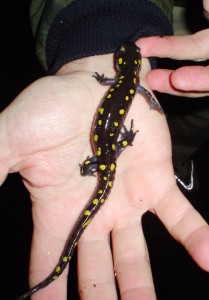Sightings – Amphibians
Observer: Paul Lauenstein
Observation Date: 7/16/10
Observation Time: 5:25 a.m.
Observation Location: Beaver Brook near tennis court
Common Name: American Bullfrog
Scientific Name: Rana catesbeiana
Comments: Bullfrogs are voracious, opportunistic, ambush predators that prey on any small animal they can overpower and stuff down their throats. Bullfrog stomachs have been found to contain rodents, small reptiles, amphibians, crayfish, birds, and bats, as well as the many invertebrates, such as insects, which are the usual food of ranid frogs. These studies revealed the bullfrog’s diet to be unique among North American ranids in the inclusion of a large percentage of aquatic animals, such as fish, tadpoles, ram’s horn snails, and dytiscid beetles. Bullfrogs can capture large, strong prey because of the powerful grip of their jaws after the initial ranid tongue strike.
More Information: Wikipedia
Observer: Paul Lauenstein
Observation Date: 5/26/14
Observation Time: 11:50 p.m.
Observation Location: Borderland State Park
Common Name: American Toad
Scientific Name: Anaxyrus americanus
Comments: Toads eat insects, so whenever I find one, I release it in my garden.
More Information: Wikipedia
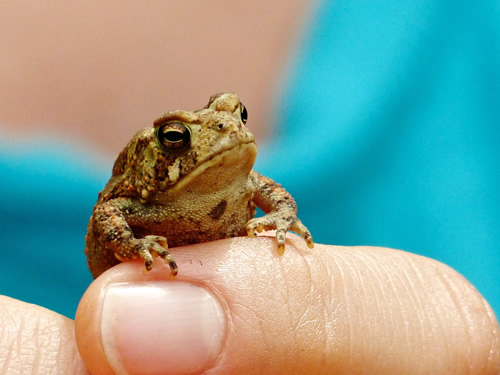
Observer: Paul Lauenstein
Observation Date: 6/17/13
Observation Time: 4:15 p.m.
Observation Location: Gavins Pond Dam
Common Name: American Toad
Scientific Name: Anaxyrus americanus
More Information: Wikipedia
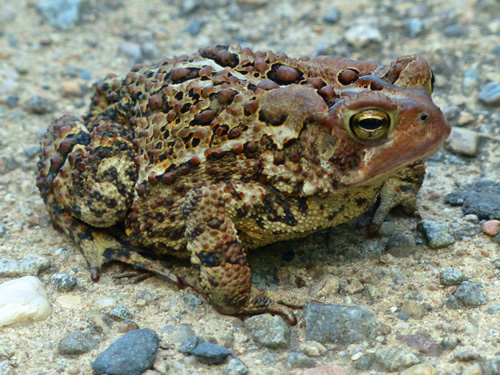
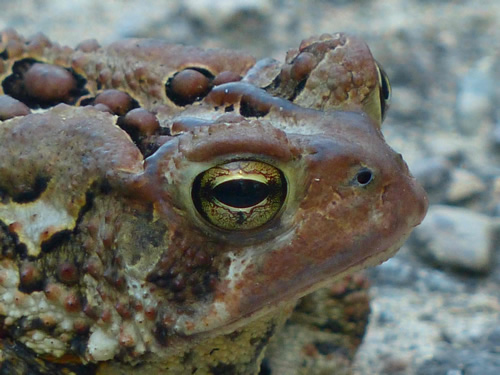
Baby toad nearby:
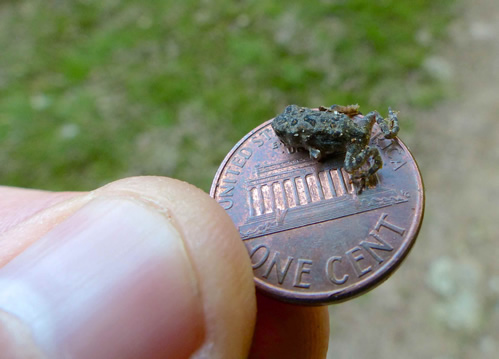
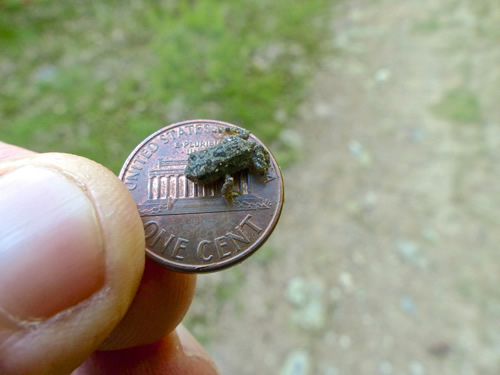
Observer: Paul Lauenstein
Observation Date: 7/16/10
Observation Time: 9:55 a.m.
Observation Location: near Gavins Pond
Common Name: American Toad (juvenile)
Scientific Name: Anaxyrus americanus
Comments: Note toe of shoe in photo to get an idea of the small size of this toad.
More Information: Wikipedia
Observer: Paul Lauenstein
Observation Date: 9/13/09
Observation Time: 2:30 p.m.
Observation Location: Bay Circuit Trail near Gorwin Drive
Common Name: American Toad
Scientific Name: Anaxyrus americanus
Comments: Notice how well this toad is camouflaged.
More Information: Animal Diversity Web

Observer: Faith Berkland
Observation Date: 10/13/12
Observation Time: 3:00 p.m.
Observation Location: 302 Mansfield Street
Common Name: Gray Tree Frog
Scientific Name: Hyla versicolor
Comments: In the crux of a spruce that has a divided trunk. But the story is, we just thought it was a toad, however I went to Franklin Park zoo this past Saturday 10/27, and there was a picture of the exact same type of frog!
More Information: Learn what a gray tree frog call sounds like at: music of nature, so you don’t wrack your brains trying to figure out what kind of bird it is.
Observer: Rita Corey
Observation Date: 5/6/23
Observation Time: 9:20 p.m.
Observation Location: Mountain St.
Common Name: Gray Tree Frog
Scientific Name: Hyla versicolor
Comments: Gray tree frogs can change color to camouflage themselves (hence the species name “versicolor”). This one was brownish to blend in better with the wall on which it was observed.
Learn what a gray tree frog call sounds like at: music of nature, so you don’t wrack your brains trying to figure out what kind of bird is singing nearby.
More Information: Wikipedia
Observer: Paul Lauenstein
Observation Date: 6/2/07
Observation Time: 10:10 a.m.
Observation Location: Trustees of Reservations Moose Hill Farm
Common Name: Gray Tree Frog
Scientific Name: Hyla versicolor
Comments: This gray tree frog was sitting motionless in the foliage along the dirt road leading through the woods to the big pasture.
More Information: Learn what a gray tree frog call sounds like at: music of nature, so you don’t wrack your brains trying to figure out what kind of bird it is!
Observer: Will Sweet
Observation Date: 7/19/08
Observation Time: 9:00 a.m.
Observation Location: Back yard garden
Common Name: Gray Tree Frog
Scientific Name: Hyla versicolor
Comments: While watering the garden, this tree frog revealed itself in a bush.
More Information: Learn what a gray tree frog call sounds like at: music of nature, so you don’t wrack your brains trying to figure out what kind of bird it is.
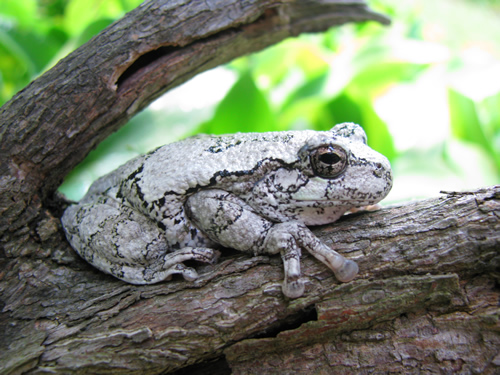
Observer: Josh Simons
Observation Date: 5/21/23
Observation Time: 2:45 p.m.
Observation Location: near Gavins Pond Dam
Common Name: Green Frog
Scientific Name: Lithobates clamitans
Comments: This is one of our most familiar frogs, and is found statewide. It has some green on its face and a mostly brown body, with a ridge running down each side of its back. This species prefers permanent or semipermanent water bodies (rather than vernal pools that dry up in summer), eating whatever it can grab, mostly insects but occasionally small snakes and even birds. The call is a banjo-like “gunk.” The female lays a thousand or more eggs at a time as a film on the water’s surface.
More Information: Wikipedia
Observer: Paul Lauenstein
Observation Date: 5/28/23
Observation Time: 12:20 p.m.
Observation Location: Moose Hill Farm (TTOR)
Common Name: Green Frog
Scientific Name: Lithobates clamitans
Comments: This is one of our most familiar frogs, and is found statewide. It has some green on its face and a mostly brown body, with a ridge running down each side of its back. This species prefers permanent or semipermanent water bodies (rather than vernal pools that dry up in summer), eating whatever it can grab, mostly insects but occasionally small snakes and even birds. The call is a banjo-like “gunk.” The female lays a thousand or more eggs at a time as a film on the water’s surface.
More Information: Wikipedia
Observer: Paul Lauenstein
Observation Date: 7/4/11
Observation Time: 4:10 p.m.
Observation Location: Gavins Pond Dam
Common Name: Green Frog
Scientific Name: Lithobates clamitans
Comments: This is one of our most familiar frogs, and is found statewide. It has some green on its face and a mostly brown body, with a ridge running down each side of its back. This species prefers permanent or semipermanent water bodies (rather than vernal pools that dry up in summer), eating whatever it can grab, mostly insects but occasionally small snakes and even birds. The call is a banjo-like “gunk.” The female lays a thousand or more eggs at a time as a film on the water’s surface.
More Information: Wikipedia
Observer: Rick Dumont
Observation Date: 5/21/09
Observation Time: 8:30 a.m.
Observation Location: Massapoag Sportsmen’s Club, Belcher St.
Common Name: Green Frog
Scientific Name: Lithobates clamitans
Comments: This is one of our most familiar frogs and is found statewide. It has a green face and a green-brown body, and a ridge running down each of its sides. This species prefers permanent or semipermanent water bodies, eating whatever it can grab, mostly insects but occasionally small snakes and even birds. The call is a banjo-like “gunk.” The female lays a thousand or more eggs at a time as a film on the water’s surface.
More Information: MassAudubon.org or Animal Diversity Web
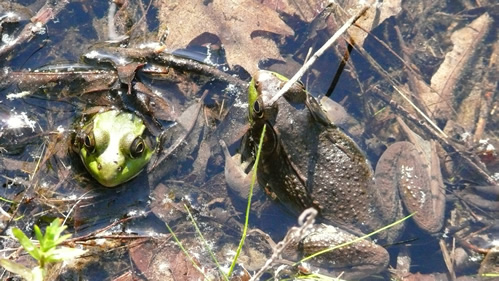
Observer: Paul Lauenstein
Observation Date: 3/17/11
Observation Time: 3:15 p.m.
Observation Location: Coach Lane
Common Name: Lead-backed salamander
Scientific Name: Plethodon cinereus
Comments: The lead-backed salamander is a color variant of the red-backed salamander. They live under rotting logs.
More Information: Fairfax County Public Schools
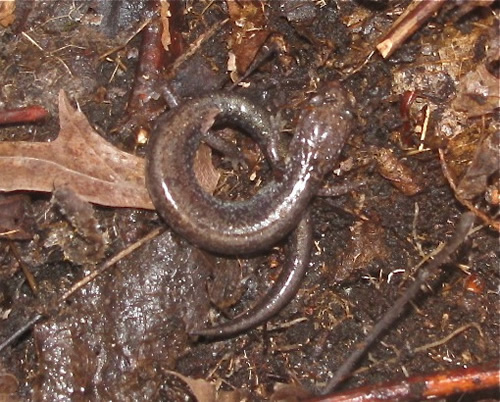
Observer: Paul Lauenstein
Observation Date: 8/11/11
Observation Time: 3:50 p.m.
Observation Location: Gavins Pond Dam
Common Name: Pickerel Frog
Scientific Name: Rana palustris
Comments: The skin secretions of a stressed pickerel frog are known to be toxic to other frogs, as many a novice frog catcher has found when he finds only the pickerel frogs still alive in his bucket. These secretions can also be moderately irritating if they come in contact with the eyes, mucous membranes, or broken skin. It is advisable to wash one’s hands after handling pickerel frogs.
Pickerel frogs look a lot like leopard frogs. Here’s where you can learn how to tell the difference: https://discovery.acadiau.ca/herpatlas/photopages/compleopick.htm
More Information: Wikipedia
Observer: Paul Lauenstein
Observation Date: 8/20/10
Observation Time: 7:45 a.m.
Observation Location: Gavins Pond Dam
Common Name: Pickerel Frog
Scientific Name: Rana palustris
Comments: The skin secretions of a stressed pickerel frog are known to be toxic to other frogs, as many a novice frog catcher has found when he finds only the pickerel frogs still alive in his bucket. These secretions can also be moderately irritating if they come in contact with the eyes, mucous membranes, or broken skin. It is advisable to wash one’s hands after handling pickerel frogs.
More Information: Wikipedia
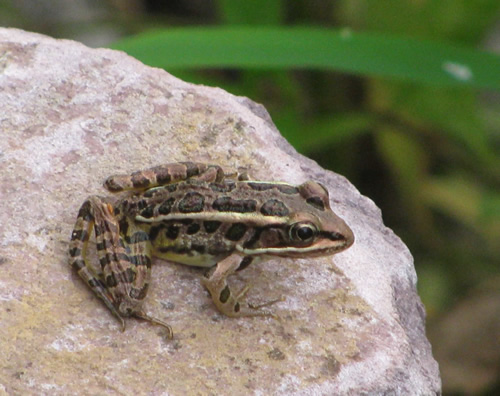
Observer: Josh Simons
Observation Date: 9/9/20
Observation Time: 11:15 a.m.
Observation Location: Moose Hill area
Common Name: Pickerel Frog
Scientific Name: Lithobates palustris
Comments: The skin secretions of a stressed pickerel frog are known to be toxic to other frogs, as many a novice frog catcher has found when he finds only the pickerel frogs still alive in his bucket. These secretions can also be moderately irritating if they come in contact with the eyes, mucous membranes, or broken skin. It is advisable to wash one’s hands after handling pickerel frogs.
Pickerel frogs look a lot like leopard frogs. Here’s where you can learn how to tell the difference: https://discovery.acadiau.ca/herpatlas/photopages/compleopick.htm
More Information: Wikipedia
Observer: Paul Lauenstein
Observation Date: 4/2/05
Observation TIme: 10:00 p.m.
Observation Location: crossing Moose Hill St. (near TTOR)
Common Name: Red eft (juvenile terrestrial form of eastern newt)
Scientific Name: Notophthalmus viridescens
Comments: The eastern newt (Notophthalmus viridescens) is a common newt of eastern North America. It frequents small lakes, ponds, and streams or nearby wet forests. The eastern newt produces tetrodotoxin, which makes the species unpalatable to predatory fish. It has a lifespan of 12 to 15 years in the wild, and it may grow to 5 in (13 cm) in length. The striking bright orange juvenile stage, which is land-dwelling, is known as a red eft.
Along with yellow-spotted salamanders, wood frogs, spring peepers and other amphibians, red efts can be found migrating to vernal pools on “Big Night” – the first rainy night after the snow melts in late March or early April.
More Information: Wikipedia
Observer: Paul Lauenstein
Observation Date: 4/10/10
Observation Time: 7:10 p.m.
Observation Location: Hockomock Swamp, Easton
Common Name: Red-backed salamander
Scientific Name: Plethodon cinereus
Comments: Red-backed salamanders can be found by turning over rotting logs in the woods.
More Information: Wikipedia
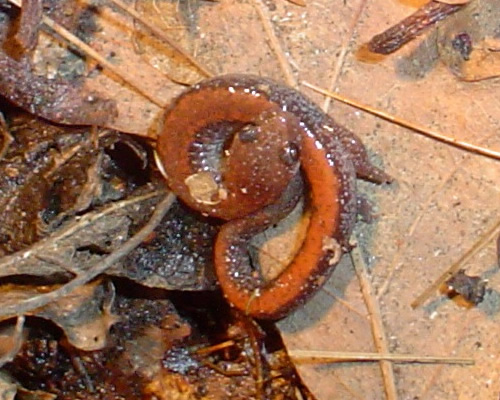
PS – Read about the salamander migration at Moose Hill in 2008.
Observer: Richard Kramer
Observation Date: 4/13/19
Observation TIme: midnight
Observation Location: Moose Hill Street near TTOR’s Moose Hill Farm
Common Name: Red-backed Salamander
Scientific Name: Plethodon cinereus
Comments: This photo was taken on “Big Night” – the first rainy night after the snow has melted in spring when a variety of woodland amphibians migrate from uplands down to nearby wetlands to spawn. To witness this amazing phenomenon, all you need is an umbrella and a flashlight. Walk carefully to avoid stepping on a frog or a salamander.
Red-backed salamanders can also be found by turning over rotting logs in the woods.
More Information: Wikipedia
Observer: Paul Lauenstein
Observation Date: 4/25/23
Observation TIme: 8:43 a.m.
Observation Location: Moose Hill Audubon Wildlife Sanctuary
Common Name: Red-backed Salamander
Scientific Name: Plethodon cinereus
Comments: Red-backed salamanders can be found by turning over rotting logs in the woods.
More Information: Wikipedia
Observer: Paul Lauenstein
Observation Date: 5/6/20
Observation TIme: 8:50 a.m.
Observation Location: conservation land near Lakeview & Morse
Common Name: Red-backed Salamander
Scientific Name: Plethodon cinereus
Comments: Red-backed salamanders can be found by turning over rotting logs in the woods.
More Information: Wikipedia
Observer: Paul Lauenstein
Observation Date: 5/7/25
Observation TIme: 10:15 a.m.
Observation Location: Moose Hill Audubon Wildlife Sanctuary
Common Name: Red-backed Salamander
Scientific Name: Plethodon cinereus
Comments: Red-backed salamanders can be found by turning over rotting logs in the woods, which is how I found these two. Note that one of them lacks red coloration. Red-backed salamanders without red pigmentation are known as a lead-backed salamanders.
When turning over dead logs in the woods, beware – there could be a yellow jacket nest underneath the log.
More Information: Wikipedia
Observer: Richard Kramer
Observation Date: 4/13/19
Observation Time: midnight
Observation Location: Moose Hill Street near TTOR’s Moose Hill Farm
Common Name: Wood Frog
Scientific Name: Rana sylvatica
Comments: As their name implies, wood frogs live in the woods and reproduce in vernal pools. Listen to the recording of the quacking sound it makes at the Wikipedia link below so you can recognize it when they thaw out after the snow melts in early spring and begin their courtship.
The photo below was taken on “big night” – the first rainy night after the snow has melted in spring when woodland amphibians migrate from uplands down to nearby wetlands to spawn.
More Information: Wikipedia
Observer: Paul Lauenstein
Observation Date: 9/13/09
Observation Time: 3:00 p.m.
Observation Location: Mass Bay Circuit Trail near Borderland State Park
Common Name: Wood Frog
Scientific Name: Rana sylvatica
Comments: Very well camouflaged in center of photo.
In case you were wondering how frogs survive the winter, check out this 2-minute time-lapse video of a frozen wood frog thawing out: https://www.youtube.com/watch?v=ofSdw5V21Ek
More Information: Wikipedia
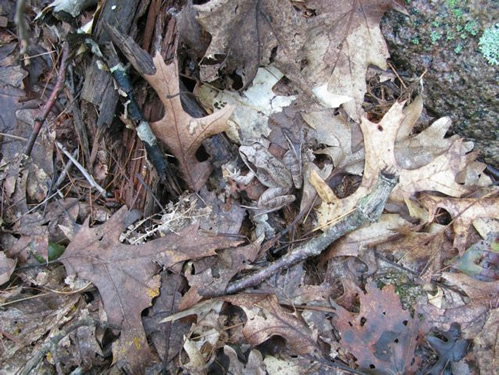
Observer: Paul Lauenstein
Observation Date: 9/13/14
Observation Time: 12:10 p.m.
Observation Location: 4 Gavins Pond Rd.
Common Name: Wood Frog
Scientific Name: Rana sylvatica
Comments: This amphibian lives in the woods and reproduces in vernal pools. Listen to the recording of the quacking sound it makes at the Wikipedia link below so you can recognize it when they thaw out after the snow melts in early spring and begin their courtship.
More Information: Wikipedia
Observer: Faith Berkland
Observation Date: 2/17/22
Observation Time: 4:20 p.m.
Observation Location: 359 Mansfield Street, Sharon
Common Name: Yellow Spotted Salamander
Scientific Name: Ambystoma maculatum
Comments: Although it’s generally best not to handle amphibians, it was on the street so I picked it up and put it under some leaves across the street before a car came. Unfortunately I did not get a photo.
Salamanders typically do not emerge until “Big Night” – the first rainy night after the snow melts in late March. Perhaps the recent warm weather (up to 60º in February) has fooled them into coming out early – a potentially fatal mistake if freezing weather returns.
More Information: animaldiversity.org
Observer: Rita Corey
Observation Date: 3/22/10
Observation Time: 10:00 p.m.
Observation Location: Between 268 & 281 Mountain St, going east to west
Common Name: Yellow Spotted Salamander
Scientific Name: Ambystoma maculatum
Comments: Rainy night; stopped car to watch it cross the road; told the neighbor driving behind me and he came out to watch: he had never seen one before.
More Information: Read about the salamander migration at Moose Hill in 2008.
Observer: Rita Corey
Observation Date: 3/23/10
Observation Time: 10:00 p.m.
Observation Location: Between 268 & 281 Mountain St, going west to east
Common Name: Yellow Spotted Salamander
Scientific Name: Ambystoma maculatum
Comments: Was it the same one I had seen the night before crossing the road? I suspect there are lots of them! Gave a note to all neighbors on Mountain St from Hampton Rd to dirt road to be on the lookout as they drive home on rainy nights.
More Information: Read about the salamander migration at Moose Hill in 2008.
Observer: Rita Corey
Observation Date: 3/29/10
Observation Time: 9:30 p.m.
Observation Location: Between 268 & 281 Mountain St, going west to east
Common Name: Yellow Spotted Salamander
Scientific Name: Ambystoma maculatum
Comments: Again, a rainy night in late March…
More Information: Read about the salamander migration at Moose Hill in 2008.
Observer: Richard Kramer
Observation Date: 4/13/19
Observation Time: midnight
Observation Location: Moose Hill Street near Kendall Estate
Common Name: Yellow Spotted Salamander
Scientific Name: Ambystoma maculatum
Comments: To see a variety of frog and salamander species on the first rainy night after the snow melts in late March or early April, take an umbrella and a flashlight, and walk down Moose Hill Street near TTOR’s Moose Hill Farm . That’s when mole salamanders migrate from their burrows to nearby wetlands to spawn.
It’s best not to handle salamanders because the salts and oils on your skin don’t do amphibians any good.
More Information: animaldiversity.org
Observer: Bruce Lewis
Observation Date: 3/13/22
Observation Time: 4:00 p.m.
Observation Location: Moose Hill St. near TTOR’s Moose Hill Farm
Common Name: Yellow Spotted Salamander
Scientific Name: Ambystoma maculatum
Comments: It’s generally best not to handle amphibians, so I left it alone.
Salamanders typically do not emerge until “Big Night” – the first rainy night after the snow melts in late March. This specimen was crawling around while it was snowing.
More Information: animaldiversity.org
Observer: Paul Lauenstein
Observation Date: 4/2/05
Observation Time: 9:00 p.m.
Observation Location: Moose Hill Street near Kendall Estate
Common Name: Yellow Spotted Salamander
Scientific Name: Ambystoma maculatum
Comments: It’s best not to handle salamanders because the salts and oils on your skin don’t do amphibians any good (mea culpa!). To see a variety of frog and salamander species, walk down Moose Hill Street on the first rainy night after the snow melts in late March. That’s when mole salamanders migrate from their their burrows to nearby wetlands to spawn.
More Information: animaldiversity.org
Observer: Scott Didham
Observation Date: 9/24/11
Observation Location: Mansfield St.
Common Name: Yellow-spotted salamander
Scientific Name: Ambystoma maculatum
More Information: Read about the salamander migration at Moose Hill in 2008.

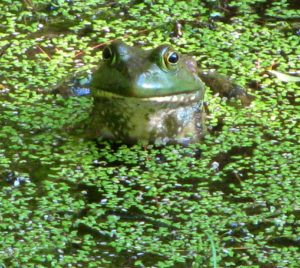
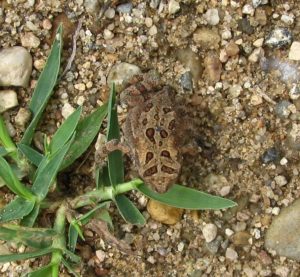
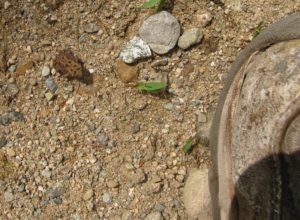

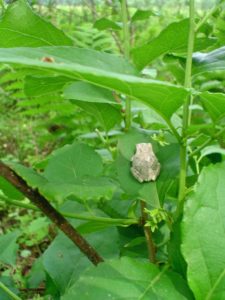
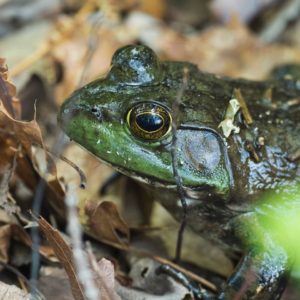
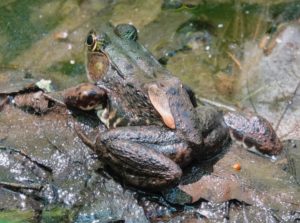
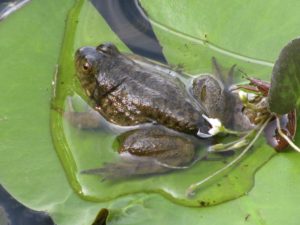
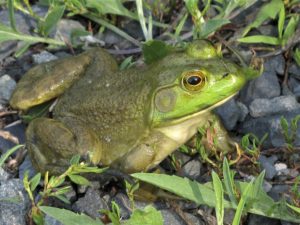
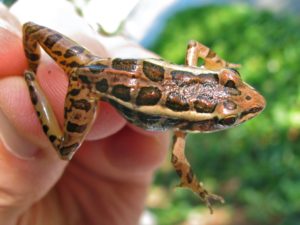
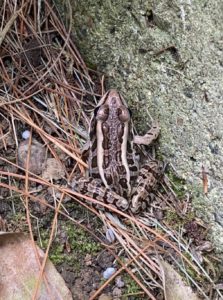
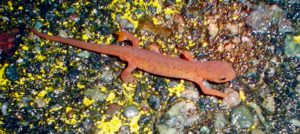
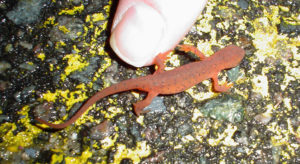
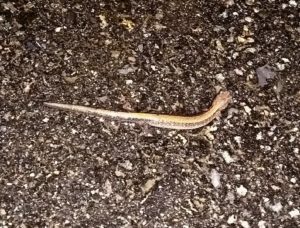
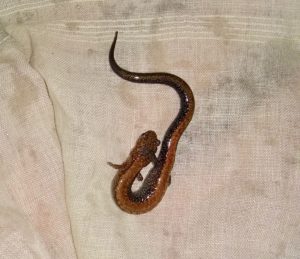
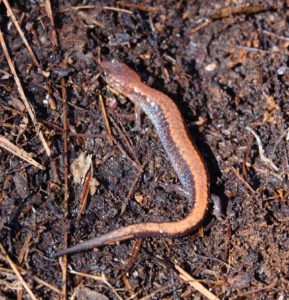
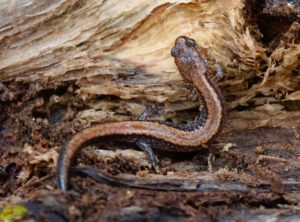

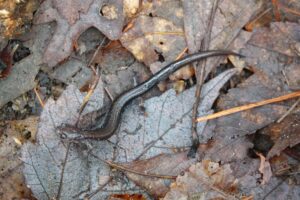
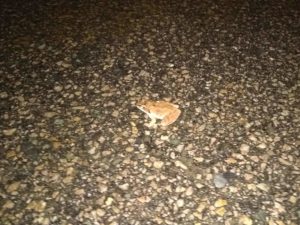
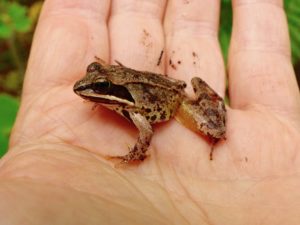
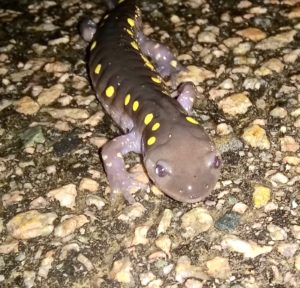
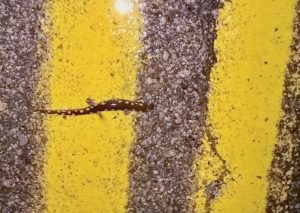
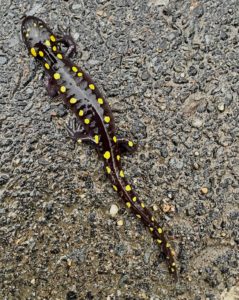 4
4